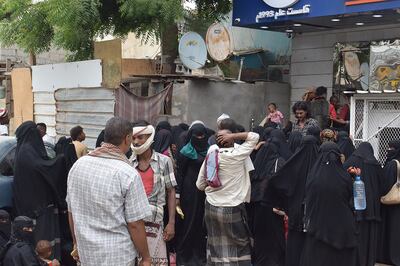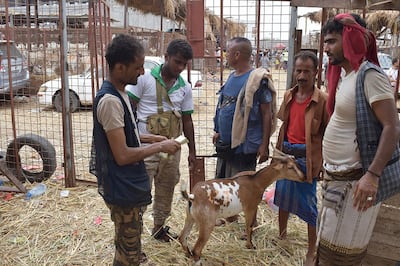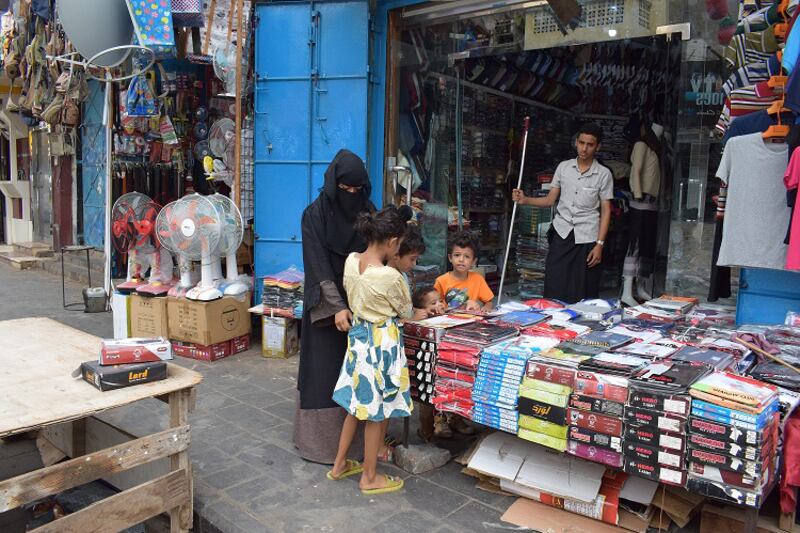Empty-handed, Aisha Mohammed left the livestock market where residents of Yemen’s southern city of Aden usually buy sacrificial animals for Eid Al Adha.
“I couldn’t afford it. Prices have spiked incredibly,” the widowed mother of five told The National as she walked out.
“I feel very devastated. It is very hard to tell my kids that I couldn’t buy Audhiya [a sacrificial animal] for them,” she said, fighting back tears.
Ms Mohammed is one of millions of Yemenis struggling to cope with rising prices caused by a sharp drop in the value of the Yemeni riyal, which has added to difficulties they face as a result of the country’s civil war.
The fall in the currency’s value has forced traders raise prices because they have to pay more for imports bought with US dollars.

In provinces controlled by the Yemeni government, the exchange rate of the riyal to one US dollar rose briefly past 1,000 last week, compared with 850 in early June.
The decline is expected to continue, said Majed Al Daeri, an economic analyst in Aden.
“The six years of war have destroyed all the economic resources of the country, such as the oil and gas, the two main resources,” Mr Al Daeri told The National.
“Also the excessive printing of banknotes by the government, which printed nearly three trillion riyals without cash cover since 2016.”
The policy has affected cash reserves and the availability of foreign currency in the local market.
“All these reasons contributed to the dramatic collapse of the national currency.”
The soaring prices mean most Yemenis cannot afford to observe Eid Al Adha traditions such as sacrificing an animal and sharing the meat with their family and the poor.
“The fact is that we haven’t started any preparations for the coming Eid because of the hard living conditions we are experiencing this year,” said Mohammed Omar, a retired policeman in Aden.
“We haven’t been paid for months and even if the government pays us one month’s wage, that means nothing with the plunge in the riyal’s value.”
Mr Omar said his monthly pension was 150,000 riyals while even the smallest sacrificial animal would cost him 100,000 riyals.
“That means we either buy Audhiya for Eid and stay without food supplies, or buy necessary foodstuffs and forget about Eid,” he said

The economic crisis is affecting sellers as well as consumers. The livestock market in Al Mansoura, the biggest cattle market in Aden, is usually crowded before Eid Al Adha. But last Wednesday, with only days to go, it had hardly any customers.
“The continuous depreciation in the Yemeni riyal hasn’t spared the livestock market,” said Abu Baker Al Alimi, a trader at the market.
“All the cattle we’re selling this year were imported from Somalia because the Yemeni livestock is very expensive. Customers can’t afford it,” he said.
He said prices this year were twice as much as last year. “The smallest goat or sheep is $100 this year, while people were able to buy a good sacrificial animal with less than $50 last year.”
Rising prices have forced parents to seek bargains while buying new clothes for their children, another Eid tradition.
“I have four kids and the money I have is not enough to buy dresses for two of them,” Rahma Ahmed told The National while shopping with her children at Al Maydan market in Aden’s Crater district.
“I convinced them to each buy a single item so that the money can cover them all,” she said
“Three years ago the money I have today would cover all their requirements.”







